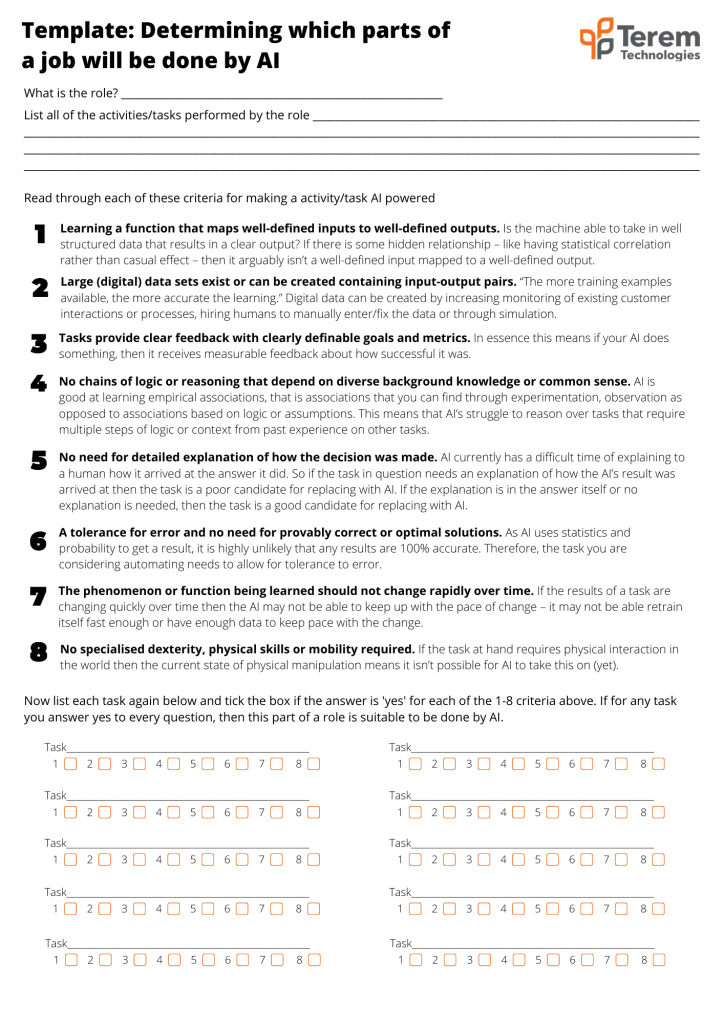
How will a job be replaced by AI (artificial intelligence)? It’s actually not that hard to understand thanks to MIT and Carnegie Melon researchers.
An occupation can be viewed as a bundle of tasks, and when viewed as a bundle of tasks we can gain a more concrete understanding of how AI will change a specific role. You then take each task the role needs to perform and determine how “suitable for machine learning” it is.
The MIT and Carnegie Melon researchers were able to evaluate how AI would impact 18,156 tasks across 2,069 work activities and 964 occupations.
So, as product developers, generally targeting a small handful of personas it’s a no brainer to use it as a framework to either uncover AI opportunities for our product, re-imagine our business model or get some cost savings from automation.
In this article we share the framework the researchers developed and provide a template for you to use to evaluate a task.
Before we get into the framework for understanding which tasks AI will replace, there is another important insight to call out from the research.
“The focus of researchers, as well as managers and entrepreneurs, should be not (just) on automation, but on job redesign.” say researchers Erik Brynjolfsson, Tom Mitchell, and Daniel Rock.
That is, to really leverage AI you need to reimagine your business, your customers business, your processes or your product. You need to think more broadly.
Now, let’s look at the framework.
Throughout the article I’ve conflated AI and ML (machine learning). Yes, there are differences but for the purposes of conveying what I’m aiming to convey here I don’t think it is an issue.
Eight Key Criteria for Most Suitable Tasks for AI
In the researcher’s paper published in Science, they put forward the following eight key criteria for determining how suitable a task is for AI to perform it:
1. Learning a function that maps well-defined inputs to well-defined outputs. Is the machine able to take in well structured data that results in a clear output? If there is some hidden relationship – like having statistical correlation rather than casual effect – then it arguably isn’t a well-defined input mapped to a well-defined output.
2. Large (digital) data sets exist or can be created containing input-output pairs. “The more training examples available, the more accurate the learning.” Digital data can be created by increasing monitoring of existing customer interactions or processes, hiring humans to manually enter/fix the data or through simulation.
3. Tasks provide clear feedback with clearly definable goals and metrics. In essence this means if your AI does something, then it receives measurable feedback about how successful it was.
4. No chains of logic or reasoning that depend on diverse background knowledge or common sense. AI is good at learning empirical associations, that is associations that you can find through experimentation, observation as opposed to associations based on logic or assumptions. This means that AI’s struggle to reason over tasks that require multiple steps of logic or context from past experience on other tasks.
5. No need for detailed explanation of how the decision was made. AI currently has a difficult time of explaining to a human how it arrived at the answer it did. So if the task in question needs an explanation of how the AI’s result was arrived at then the task is a poor candidate for replacing with AI. If the explanation is in the answer itself or no explanation is needed, then the task is a good candidate for replacing with AI.
6. A tolerance for error and no need for provably correct or optimal solutions. As AI uses statistics and probability to get a result, it is highly unlikely that any results are 100% accurate. Therefore, the task you are considering automating needs to allow for tolerance to error. Which, in many cases, theory would suggest there is, because humans make errors however in practical terms I’ve observed people are often more comfortable with humans making errors.
7. The phenomenon or function being learned should not change rapidly over time. If the results of a task are changing quickly over time then the AI may not be able to keep up with the pace of change – it may not be able retrain itself fast enough or have enough data to keep pace with the change. The more stable the input/output relationship over time the easier to replace, the less stable the harder to replace.
8. No specialized dexterity, physical skills or mobility required. If the task at hand requires physical interaction in the world then the current state of physical manipulation means it isn’t possible for AI to take this on (yet).
I’ve taken the criteria almost as is and rephrased where I thought it would make it easier for someone short on time to digest. That being said, the original authors wording was relatively easy to digest.
How to apply the MIT framework
The steps to apply this framework are:
1. Write out the role/job you want to improve/replace/augment with AI.
2. List all the activities/tasks that job performs (the more granular the better, but start broad)
3. Evaluate each task against the criteria listed above.
A template for determining which parts of a job will be done by AI
To help you apply the research we’ve developed a template
